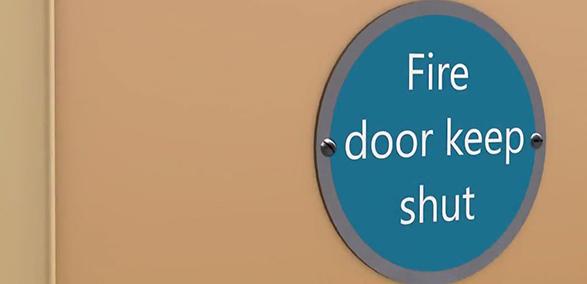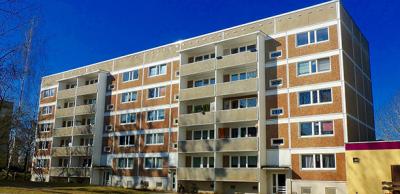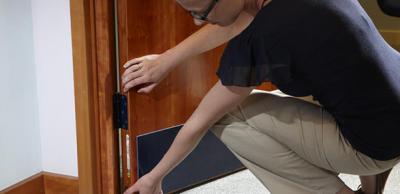Fire Door Safety Week: 5 Step Fire Door Check
Fire Door Safety Week is giving these tips for a 5 Step Fire Door Check that anyone can do:
- Check for certification: Is there a label or plug on top (or occasionally on the side) of the door to show it is a certificated fire door? If there is, that’s good news, otherwise report it to whoever is in charge of your building.
- Check the gaps: The gaps around the top and sides of the door should be consistently less than 4mm when closed. A £1 coin is about 3mm thick so use that to give a feel for the scale. The gap under the door can be slightly larger (up to 8mm is not uncommon), but it does depend on the door. As a rule of thumb, if you can see light under the door, the gap is likely to be too big. If the gaps are too big smoke and fire could travel through the cracks. It’s good news if the door fits the frame and it’s not damaged. If not, report it.
- Check the seals: Are there any intumescent seals around the door or frame, and are they intact with no sign of damage? These seals are vital to the fire door's performance, expanding if in contact with heat to ensure fire (and in some cases smoke) can’t move through the cracks. If not, report it - the door may not be properly maintained and in the intensity of a fire may not protect you for long enough.
- Check the hinges: Are the hinges firmly fixed (three or more of them), with no missing or broken screws? If you see problems, report it - the door is obviously not properly maintained and in the intensity of a fire it may not perform and hold back the fire for long enough.
- Check the door closes properly: Open the door about halfway, let go and allow it to close by itself. Does it close firmly onto the latch without sticking on the floor or the frame? If not, report it. A fire door only works when it’s closed. A fire door is completely useless if it’s wedged open or can’t close fully.
Download the 5 Step Fire Door Check here
The correct specification, supply, fitting and maintenance are critical and the responsibility of each and every person in the process. It’s only when a fire breaks out that the consequences of poorly manufactured or fitted fire doors are known.
This Best Practice Guide has been prepared by BWF-Certifire Fire Door Scheme. It is the complete reference source for everything that you and your customer need to know about third party certificated timber fire doors and doorsets.
Get it right = Protect Lives and Property
Get it wrong = Risk to Life and Property
The guide is for anyone in the fire door supply chain, from raw material or component supplier, right through to the customer. It has been spilt into sections to lead you through your responsibilities and actions at every stage of the process...
The Fire Door Process
- A basic introduction to fire doors
- Design and specification
- Ordering and procurement
- Delivery and storage
- Installation
- Using, maintenance and inspection
The guide is accompanied by easy to use checklists and pictures to support at every stage of the process and help the user recognise areas of risk in the fire door chain.
Further information
Find out more at www.bwfcertifire.org.uk
http://www.bwfcertifire.org.uk/assets/bwf-best-practice-guide-2016.pdf
Sign up to the building bulletin newsletter
Over 48,000 construction professionals have already signed up for the LABC Building Bulletin.
Join them and receive useful tips, practical technical information and industry news by email once every 6 weeks.
Subscribe to the Building Bulletin




Comments
Gap?
Submitted 6 years 7 months ago
Reply
Submitted 6 years 7 months ago
Here's the reply from our technical team:
The 8mm dimension has been taken by BWF as the reasonable gap ensuring continued performance of a fire door. This differs from the 10mm gap mentioned in Approved Document F to achieve adequate ventilation through air changes within rooms.
BS8214: 2008 Timber-based fire door assemblies – Code of practice recommended a 6mm gap but has since been superseded by BS 8214:2016 which has been reworded in 9.5.3 Under-door (threshold) gaps to read; Under-door (threshold) gaps should be in accordance with the fire door manufacturer’s installation instructions for the particular design.
NOTE 1 Gaps larger than those approved are likely to compromise the fire resistance performance of the door assembly.
This is because when tested in accordance with BS 476: Section 31.1 (or BS EN 1634–3) with the threshold taped and subjected to a pressure of 25Pa, have a smoke leakage rate not exceeding 3m3/m/h.
Thanks, Julie
Webmaster note
Submitted 6 years 7 months ago
FIRE DOORS
Submitted 5 years 8 months ago
(FD30s)
Maximum gaps allowed fire doors
Submitted 1 year 8 months ago
I am not convinced. Advise please.
LABC Response
Submitted 1 year 8 months ago
Thank you for your enquiry, however, the answer will be dependent upon your particular circumstances, and this is not something that LABC can help with, however we would refer you to Fire Safety (England) Regulations 2022: fire door guidance - GOV.UK (www.gov.uk) for the latest government advice on flat entrance doors. We are sorry we cannot be of further assistance, but hope you find the above to be of some help.
Best,
LABC Team
(No subject)
Submitted 1 year 7 months ago
I’ve read Approved Document B Volume 1, 2019 edition. Page 139. Appendix C: Fire Doorsets. Table C1 - 11b and it looks like it is not a requirement in this situation. Just a FD20. There isn’t a “S” classification noted.
Any help would be appreciated.
LABC Response
Submitted 1 year 7 months ago
Thank you for your enquiry.
The reference in the tables in approved document B that you refer to, by the “S” suffix are for cold smoke seals.
These are not intumescent strips. For an FD20 door (albeit FD20 doors are no longer manufactured and therefore and FD30 door will be necessary) you will need to refer to the manufacturers test evidence and datasheets for the fitting of intumescent strips and in our view the test data will require intumescent strips to be fitted in a protected stair.
Best,
LABC Team
Add new comment